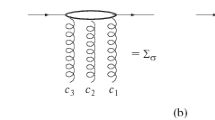Summary
A Regge-cut model which incorporates the Veneziano amplitude extrapolated to off the mass shell in the reggeon-diagram technique is proposed. The cut satisfies Mandelstam’s criteria on cutgenerating diagrams, and the discontinuity across Regge cuts is parametrized by relatively few free parameters. Qualitative predictions about some high-energy reactions are derived from the assumption of nonexotic resonances and the dominance of leading poles in the Veneziano amplitudes.
Riassunto
Si propone un modello di tagli di Regge che incorpora l’ampiezza di Veneziano estrapolata fuori dello strato delle masse nella tecnica del diagramma dei reggeoni. Il taglio soddisfa i criteri di Mandelstam sui diagrammi generatori di tagli, e la discontinuità attraverso i tagli di Regge è parametrizzata con un numero relativamente piccolo di parametri. Dall’ipotesi che non vi siano risonanze esotiche e dalla predominanza dei poli principali nelle ampiezze di Veneziano si traggono predizioni su alcune reazioni di alta energia.
Реэюме
Предлагается модель раэреэа Редже, которая испольэует амплитуду Венециано, зкстраполированную вне массовой поверхности в технике реджеонных диаграмм. Этот раэреэ удовлетворяет критерию Манделстама на диаграммах, обраэуюших раэреэ. Скачок на раэреэах Редже параметриэуется с помошью нескольких свободных параметров. Выводятся качественные предскаэания относительно некоторых реакций при высоких знергиях, исходя иэ предположения об отсутствии зкэотических реэонансов и доминантности главных полюсов в амплитудах Венециано.
Similar content being viewed by others
References
A. M. Boyarski, R. Diebold, S. D. Ecklund, G. E. Fischer, Y. Murata, B. Richter andM. Sands:Phys. Rev. Lett.,25, 695 (1970).
For example, seeL. Di Lella:Proceedings of the Lund International Conference of Elementary Particles (Lund, 1969), p. 152. For more general discussions for the necessity of Regge cuts, seeJ. D. Jackson:Rev. Mod. Phys.,42, 12 (1970).
The following list of references is not exhaustive, but represents some typical ones proposed recently. General:R. C. Arnold:Phys. Rev.,153, 1523 (1967);J. Finkelstein andM. Jacob:Nuovo Cimento,56 A, 681 (1968);C. B. Chiu andJ. Finkelstein:Nuovo Cimento,57 A, 649 (1968);J. Froyland:Nucl. Phys.,11 B, 204 (1969);J. Froyland andD. Gordon:Phys. Rev.,177, 2500 (1969);A. Capella andJ. Tran Thanh Van:Lett. Nuovo Cimento,1, 321 (1969).
So-called weak Regge cuts:R. C. Arnold andM. L. Blackmon:Phys. Rev.,176, 2082 (1968);M. L. Blackmon, G. Kramer andK. Schilling:Phys. Rev.,183, 1452 (1969);A. P. Contogouris andJ. P. Lebrun:Nuovo Cimento,64 A, 627 (1969);M. Colocci: CERN TH-1150 (1970).
So-called strong Regge cuts:F. Henyey, G. L. Kane, J. Pumplin andM. H. Ross:Phys. Rev. Lett.,21, 946 (1968);Phys. Rev.,182, 1579 (1969);R. L. Kelly, G. L. Kane andF. H. Henyey:Phys. Rev. Lett.,24, 1511 (1970).
Diffractive corrections:M. Biyajima, S. Sakai andT. Watanabe:Progr. Theor. Phys.,42, 282 (1969) and a series of papers byM. Biyajima and his collaborators subsequently published inProgr. Theor. Phys.
Duality-preserving Regge cuts:V. Barger andR. J. N. Phillips:Phys. Lett.,29 B, 676 (1969).
G. Veneziano:Nuovo Cimento,57 A, 190 (1968).
For a recent review of the dual-resonance model, seeD. Amati: CERN TH-1231 (1970).
K. Kikkawa, B. Sakita andM. A. Virasoro:Phys. Rev.,184, 1701 (1969).
K. Kikkawa:Phys. Rev.,187, 2249 (1969);R. J. Rivers andJ. J. G. Scanio:Phys. Rev.,188, 2170 (1969).
V. N. Gribov:Žurn. Ėksp. Teor. Fiz.,53, 654 (1967) (English translation:Sov. Phys. JETP,26, 414 (1968)).
S. Mandelstam:Nuovo Cimento,30, 1127, 1148 (1963).
D. Amati, S. Fubini andA. Stanghellini:Nuovo Cimento,26, 896 (1962).
An analysis of the lowest-order diagram has been carried out byH. J. Rothe:Phys. Rev.,159, 1471 (1967).
A. B. Kaidalov andB. M. Karnakov:Phys. Lett.,29 B, 372, 376 (1969);Sov. Journ. Nucl. Phys.,11, 121 (1970).
C. Lovelace:Phys. Lett.,28 B, 265 (1969).
The Veneziano amplitude for the processπρ → ρπ is helpful for our purpose. See, for example,K. Itabashi, Y. Kohsaka, S. Miyake andF. Takagi:Progr. Theor. Phys.,42, 1151 (1969).
Author information
Authors and Affiliations
Additional information
To speed up publication, the authors of this paper have agreed to not receive the proofs for correction.
Rights and permissions
About this article
Cite this article
Kobayashi, T., Yamagishi, K. A phenomenological model of Regge cuts based on the reggeon-diagram technique. Qualitative considerations. Nuov Cim A 6, 232–240 (1971). https://doi.org/10.1007/BF02728597
Received:
Revised:
Published:
Issue Date:
DOI: https://doi.org/10.1007/BF02728597



